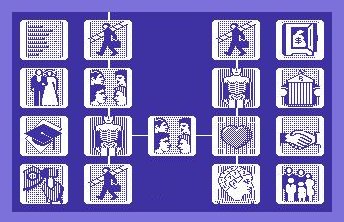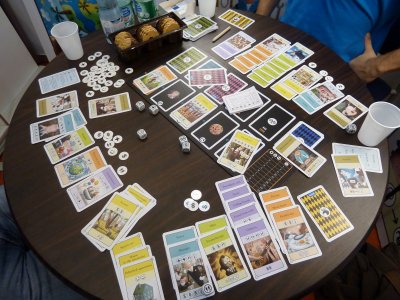

![[IMAGE]](../bilder/cv1.jpg) |
Author: Publisher: No. of Players: |
![[IMAGE]](../technik/box/rot/rot-4.gif) ![[IMAGE]](../technik/box/gelb/gelb-8.gif) ![[IMAGE]](../technik/box/grun/grun-4.gif) ![[IMAGE]](../technik/box/pink/pink-6.gif) ![[IMAGE]](../technik/box/blau/blau-8.gif) |
|
Over the years there have always been game releases which remind me of some old computer games which I have played on my Commodore 64 (the grandfather of all home computers). Looking at the topic alone, the new game CV by Filip Milunski (one of the co-authors of Magnum Sal) is one of these games, since its theme - the creation of a fictional CV - strongly reminds me of the computer classic Alter Ego which was released by ACTIVISION in 1986. Alter Ego was (and in some ways still is) a milestone in the history of computer gaming, since it realized its topic - the creation of a fictional CV - with astonishing complexity. Graphics only played a minor role in this game - most of it was pure written text. The game occupied several 166k Floppy Disks - which was at that time a tremendous amount of data. Even in our modern times of Gigabytes it takes a lot of plain text to get a file size of 166k, and so it's no wonder that the game did not take minutes or hours to play, but it actually took several days (unless - of course - the fictional character found an early end due to an accident or ill health). By the way, Alter Ego was co-developed by psychologist Peter J. Favaro, and so all the texts were not purely fictional, but instead the whole playing experience was arranged in a way to allow the player some interesting reflections about his own personality.
 If all this has catched your interest, you may actually try Alter Ego without any major problems, since a browser version and apps of the game has been created. If you have a Google-account, you may even save your browser game and return later. You may visit the Alter Ego Website to start your own Alter Ego, but for the moment it's better if you stay reading this review - otherwise you will be distracted for hours! After all this has been said, let's not forget that this just has been the introduction for a new boardgame! Indeed, CV challenges the players to create the stories of fictional characters, but all this will be finished within the normal time-frame of a boardgame, and not during long hours of playing in front of a screen. In its core mechanism CV resorts to a dice-rolling mechanism which is similar to Roll through the Ages: a hand of symbol dice is rolled, and the dice may be re-rolled up to two times. An exception are dice showing a "Bad luck" symbol, since these dice are locked for the player's current turn and may not be re-rolled. Apart from this, the other symbols are "Health", "Knowledge", "Relationship", "Money" and "Good luck", and when a player has finished his rolls he will be allowed to invest these symbols into the creation of his path of life. The cv of each player's character is created through the acquisition of cards belonging to the categories of "Health", "Knowledge", "Relationship", "Work", "Possession" and "Event", and the currently available cards are displayed on a central gameboard. At the beginning of the game each player drafted some one-use "childhood" Event cards which can be used during the game, and all the cards on the central board come from a deck of "early adulthood" cards which will also be used to refill the board when cards have been purchased by the use of dice symbols. When this deck of cards is used up, the next deck will be the "middle age" cards, and this in turn will be followed by another deck of "old age" cards. In a way, this reminds a bit of Through the Ages, since this game also featured decks of cards from different ages which came into play one after the other.  As indicated, the players use their dice to purchase cards from the central board, and all cards available there show their "price" in form of different combinations of symbols. If a player has rolled three "Good luck" symbols, he will be allowed to freely choose one of the available cards, regardless of its original cost. All acquired cards will be sorted by the player into the aforementioned groups, with the cards overlapping each other so that only the topmost card will be fully visible. This arrangement of the cards serves the purpose to show which special abilities are available to a player, since only the special ability of the topmost card of each group in a player's cv will be usable by the player. Most of these abilities give in-game benefits like additional symbols or an additional dice which can be used to make purchases in following rounds. The game ends when the "old age" deck has been used up, and now each player will calculate his victory points. The cards from the "relationship", "health" and "knowledge" groups now will score victory points depending on the number of cards acquired from each group, whereas all "possessions" will score victory points depending on their individual value. Additional points can be scored by fulfilling the conditions listed on "life goal" cards, some of which some have been secretly assigned to the players at the beginning of the game, whereas others are openly available and will award the player who has fulfilled them best. All this brings us back to a comparison of CV and Roll through the Ages, since both the handling of the dice and the final scoring offer some palpable similarities. Another factor demonstrating the closeness of both games is player interaction, since the interaction in both games remains mostly indirect because the players just compete for the acquisition of the most useful cards (respectively of the most valuable monuments). However, CV comes with the notable difference that the broad range of available cards offers a much broader choice of useful or valuable additions to a player's CV, and in addition the "life goal" cards give the players some indication where they should focus their efforts in order to score some additional victory points. Roll through the Ages has been a nominee for the International Gamers Awards and the Spiel des Jahres, but on the long time the game's attractiveness decreased due to the restricted choice of available inventions and monuments. The small expansion Late Bronze Age brought a bit of relief due to some additional inventions and a trading mechanism, but on the long run even this expansion cannot compensate the much broader approach which has been taken by Filip Milunski in CV. As it seems, the visitor here at the SPIEL are thinking along the same lines, since Filip told me that the sales are going well and that the game is really appreciated by many visitors. Despite the fact that the game shows the mentioned similarities with other games, it brings enough originality to claim its own place on the games market. Even more, Filip actually succeeded in overcoming some of the long-term shortfalls of Roll through the Ages, and so the game can be recommended without reservations to all friends of games featuring dice as part of the playing engine.  | ||
|
| ||

|
|

|
|
| ||
|
Impressum / Contact Info / Disclaimer Kulkmann@aol.com
Copyright & copy; 2014 Frank Schulte-Kulkmann, Essen, Germany | ||